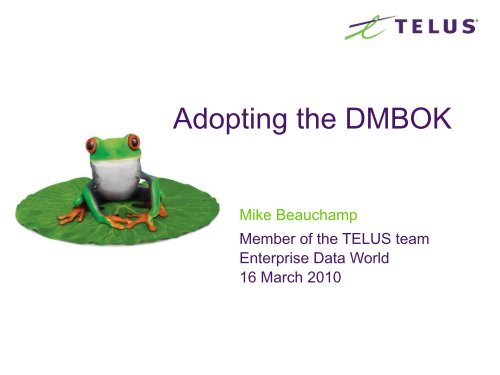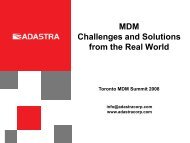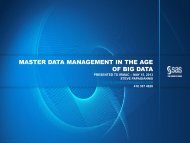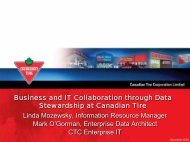Adopting the DMBOK - Information Resource Management ...
Adopting the DMBOK - Information Resource Management ...
Adopting the DMBOK - Information Resource Management ...
You also want an ePaper? Increase the reach of your titles
YUMPU automatically turns print PDFs into web optimized ePapers that Google loves.
<strong>Adopting</strong> <strong>the</strong> <strong>DMBOK</strong><br />
Mike Beauchamp<br />
Member of <strong>the</strong> TELUS team<br />
Enterprise Data World<br />
16 March 2010
Agenda<br />
• The Birth of a DMO at TELUS<br />
• TELUS DMO Functions<br />
• DMO Guidance<br />
• <strong>DMBOK</strong> functions and TELUS Priorities<br />
• Adoption Obstacles<br />
• Future Considerations<br />
2<br />
Enterprise Data World 2010 – <strong>Adopting</strong> <strong>the</strong> <strong>DMBOK</strong>
The DMO is Born
Timeline<br />
• Late 2008 – Data <strong>Management</strong> team created as a<br />
‘mashup’ of DA, DBA and BI groups.<br />
• Early 2009 – <strong>DMBOK</strong> published by DAMA. Review of<br />
TELUS Data Strategy and Data <strong>Management</strong> functions<br />
conducted by Data <strong>Management</strong> team.<br />
• April 2009 – EDW 2009, TELUS purchases a copy of<br />
<strong>DMBOK</strong>.<br />
• Jun 2009 –DAMA <strong>DMBOK</strong> adopted as <strong>the</strong> framework<br />
of reference for a TELUS Data <strong>Management</strong><br />
Organization (DMO)<br />
4<br />
Enterprise Data World 2010 – <strong>Adopting</strong> <strong>the</strong> <strong>DMBOK</strong>
Data <strong>Management</strong> Organization (DMO)<br />
• Making TELUS ‘Smarter’<br />
• ‘Smarter’ means: ensuring TELUS has <strong>the</strong><br />
information it needs to operate, thrive and compete<br />
• More focus on:<br />
• Understanding our current assets<br />
• Cleaning up <strong>the</strong> “pollution”<br />
• Data Governance (long term, enterprise view) –<br />
preventing fur<strong>the</strong>r “pollution”<br />
• Getting information into <strong>the</strong> hands of decision makers<br />
5<br />
Enterprise Data World 2010 – <strong>Adopting</strong> <strong>the</strong> <strong>DMBOK</strong>
Data Governance<br />
• Governance is not <strong>the</strong> same as <strong>Management</strong>, but<br />
should co-ordinate management activities.<br />
• Governance occurs through successful execution of<br />
co-ordinated management functions and aligned<br />
processes.<br />
• How mature is our current Governance? Where<br />
should we be as a target?<br />
• What are <strong>the</strong> functional priorities?<br />
6<br />
Enterprise Data World 2010 – <strong>Adopting</strong> <strong>the</strong> <strong>DMBOK</strong>
Data Governance Maturity Model<br />
7<br />
Enterprise Data World 2010 – <strong>Adopting</strong> <strong>the</strong> <strong>DMBOK</strong><br />
From “The Data Asset”, Tony Fisher, Wiley and Sons, 2009
TELUS<br />
DMO Functions
Organizational Review<br />
• DA, DBA, and BI functions are mature and<br />
formalized as separate teams, but need to become<br />
integrated under a Data <strong>Management</strong> mandate.<br />
• What does that process model look like? What o<strong>the</strong>r<br />
functions need to be included?<br />
• How do we organize <strong>the</strong> DMO to functionally<br />
integrate what we are currently doing with what we<br />
need to add to <strong>the</strong> functional mix?<br />
• Is <strong>the</strong>re something published that we can adopt and<br />
adapt to?<br />
9<br />
Enterprise Data World 2010 – <strong>Adopting</strong> <strong>the</strong> <strong>DMBOK</strong>
TELUS DMO Functions – at creation<br />
• DA, DBA, and BI functions considered core competencies of <strong>the</strong><br />
new TELUS DMO<br />
• Master Data <strong>Management</strong>, Metadata <strong>Management</strong>, and Data<br />
Quality dispersed across many areas, but understood to be<br />
‘developing’ competencies of <strong>the</strong> TELUS DMO.<br />
• Content <strong>Management</strong> not clearly understood as a DMO priority,<br />
but seen as <strong>the</strong> logical place to manage metadata and taxonomies<br />
for unstructured and semi-structured content.<br />
• DA team to continue in a ‘dotted line’ relationship with IT<br />
Architecture to maintain alignment with Application and<br />
Technology domains.<br />
10 Enterprise Data World 2010 – <strong>Adopting</strong> <strong>the</strong> <strong>DMBOK</strong>
DMO Guidance
Burton Group<br />
12<br />
• The Data <strong>Management</strong> Organization: Key to Effective<br />
Data <strong>Management</strong> v 1.0, 4 May 2009, Author(s): Noreen<br />
Kendle<br />
• Data <strong>Management</strong> is viewed as a governing body,<br />
responsible for Modeling activities, and connected to<br />
o<strong>the</strong>r Data related IT functions<br />
• The Burton model involves Data Architecture, Policies,<br />
Practices, and Processes and is used to support and<br />
protect an organization’s data assets<br />
• The TELUS DMO also has direct responsibility for<br />
Business Intelligence and Database <strong>Management</strong>. The<br />
Burton model is useful for Data Architecture and<br />
Strategy, but a broader Functional framework is needed<br />
• See also: 2010 Planning Guide: Data <strong>Management</strong><br />
Strategies v 1.0, 3 September 2009, Author(s): Lyn<br />
Robison<br />
12 Enterprise Data World 2010 – <strong>Adopting</strong> <strong>the</strong> <strong>DMBOK</strong>
Forrester<br />
• Forrester provides a rich perspective for Data <strong>Management</strong> functions<br />
such as Master Data <strong>Management</strong>, Data Warehousing/Business<br />
Intelligence, Data Quality and Enterprise Data Integration.<br />
• An overall framework for Data <strong>Management</strong>, however, doesn’t<br />
appear to exist.<br />
• For Data Governance, see “Data Governance: What Works And<br />
What Doesn‘t by Rob Karel with J. Paul Kirby, Boris Evelson ,<br />
September 10, 2007”<br />
• Seriously consider joining <strong>the</strong> <strong>Information</strong> and Knowledge<br />
<strong>Management</strong> Professional channel.<br />
13 Enterprise Data World 2010 – <strong>Adopting</strong> <strong>the</strong> <strong>DMBOK</strong>
Gartner<br />
• The Gartner Data <strong>Management</strong> and Integration Vendor Guide, April<br />
2009, Regina Casonato, Mark A. Beyer, Ted Friedman<br />
• Limited to Structured Data Assets<br />
• Provides guidance to <strong>the</strong> large Vendor landscape in four areas:<br />
• Data Quality Tools<br />
• Data Integration Tools<br />
• Database <strong>Management</strong> Systems<br />
• Data Warehouse DBMS’s<br />
• Also has a list of “Cool” vendors<br />
14 Enterprise Data World 2010 – <strong>Adopting</strong> <strong>the</strong> <strong>DMBOK</strong>
Enter <strong>the</strong> <strong>DMBOK</strong><br />
15 Enterprise Data World 2010 – <strong>Adopting</strong> <strong>the</strong> <strong>DMBOK</strong>
<strong>DMBOK</strong> Activities<br />
• Appendix 9 of <strong>the</strong> <strong>DMBOK</strong> lists all of <strong>the</strong> Data <strong>Management</strong> activities by<br />
<strong>Management</strong> Function<br />
• I think John’s comment was “This is exactly what I’ve been looking for!”<br />
16 Enterprise Data World 2010 – <strong>Adopting</strong> <strong>the</strong> <strong>DMBOK</strong>
<strong>DMBOK</strong> and<br />
TELUS Priorities
TELUS DMO and <strong>DMBOK</strong><br />
• 9 separate management functions<br />
surrounding Data Governance<br />
• Currently covered by TELUS DMO: Data<br />
Architecture, Data Development, Database<br />
Operations, Data Warehousing/Business<br />
Intelligence<br />
• Data Security managed in partnership with<br />
Corporate Security<br />
• Areas for DMO organizational enhancement:<br />
Data Quality, Metadata, and MDM<br />
• Still not sure what to do about Document and<br />
Content <strong>Management</strong>, but everything else<br />
seems to fit<br />
• Do our activities match <strong>DMBOK</strong> activities?<br />
18 Enterprise Data World 2010 – <strong>Adopting</strong> <strong>the</strong> <strong>DMBOK</strong>
Self Assessment<br />
19 Enterprise Data World 2010 – <strong>Adopting</strong> <strong>the</strong> <strong>DMBOK</strong>
Metadata <strong>Management</strong> at TELUS<br />
• The Data <strong>Management</strong> Organization (or DMO) at TELUS, is <strong>the</strong> group responsible for<br />
managing <strong>the</strong> Data Assets of <strong>the</strong> enterprise. The Metadata associated with this<br />
governance of Data Assets should also be managed by us and integrated with<br />
appropriate discipline.<br />
• Metadata <strong>the</strong> DMO manages reasonably well:<br />
• Data 'at rest' (published) and where movement is managed<br />
• Inclusive of Database specifications, data models, business intelligence<br />
frameworks and components, data mapping and transformation<br />
• Metadata for which <strong>the</strong> DMO needs to develop management processes:<br />
• KPI's, Common Business Vocabulary, Reporting, Operational Metadata for DW-<br />
BIM, MDM, Data Quality functions, Business Process Workflow, SOA,<br />
• Things we don’t currently manage (although we should participate and govern):<br />
• ERP, Configuration <strong>Management</strong>, Content <strong>Management</strong><br />
• Things where <strong>the</strong> lines are blurred<br />
• BPM, Unstructured data, embedded metadata (data truly 'in motion')<br />
• Web 2.0, Mashups, Enterprise Search, Text Analytics<br />
20 Enterprise Data World 2010 – <strong>Adopting</strong> <strong>the</strong> <strong>DMBOK</strong>
21 Enterprise Data World 2010 – <strong>Adopting</strong> <strong>the</strong> <strong>DMBOK</strong>
TELUS Metadata Strategy<br />
• “A metadata strategy is a statement of direction in Metadata<br />
<strong>Management</strong> by <strong>the</strong> Enterprise” – DAMA-<strong>DMBOK</strong><br />
• Metadata <strong>Management</strong> has three basic enterprise organizational models<br />
1)Centralized: All metadata is captured, managed and disseminated from a<br />
corporate repository. Sometimes called <strong>the</strong> 'uber' repository.<br />
2)Federated: Metadata is managed within defined 'domains' or 'zones'. Governance<br />
mechanisms across <strong>the</strong> zones are defined and a Metadata Integration Plan is<br />
developed to manage metadata movement between <strong>the</strong> federated domains.<br />
3)Localized: All metadata locations are responsible for managing and governing<br />
<strong>the</strong>ir own metadata independent of each o<strong>the</strong>r. Interface agreements are<br />
developed on a discovery basis as <strong>the</strong> needs of IT projects execute.<br />
• TELUS currently operates under a Localized model, but desires to<br />
operate under a Federated model. This Federated model is not a<br />
<strong>DMBOK</strong> model<br />
22 Enterprise Data World 2010 – <strong>Adopting</strong> <strong>the</strong> <strong>DMBOK</strong>
Federation and <strong>DMBOK</strong> Metadata Architecture<br />
• The <strong>DMBOK</strong> describes three approaches to Metadata Architecture (section 11)<br />
1. Centralized – use of a single Metadata Repository that contains copies of<br />
Metadata from identified, relevant sources for <strong>the</strong> domain under management<br />
2. Distributed – no persistent repository. A metadata retrieval engine uses metadata<br />
virtualization technologies to access metadata from local sources in real time.<br />
3. Hybrid – persistent repository used for “user-added” metadata as enhancements<br />
to metadata are retrieved from source in real time through virtualization.<br />
• The <strong>DMBOK</strong> does not specifically define a federated approach to Metadata<br />
<strong>Management</strong> with respect to <strong>the</strong> organization of Metadata <strong>Management</strong> Domains<br />
• Within <strong>the</strong> TELUS DMO Domain <strong>the</strong> Centralized Metadata Architecture as described<br />
in section 11, will apply (as opposed to Distributed or Hybrid). Should this be an<br />
Enterprise approach applying to all o<strong>the</strong>r domains? (recommended).<br />
• Should support “Repository to Repository” co-operation with <strong>the</strong> DMO Domain playing<br />
<strong>the</strong> role of an Integration Hub for <strong>the</strong> Enterprise.<br />
23 Enterprise Data World 2010 – <strong>Adopting</strong> <strong>the</strong> <strong>DMBOK</strong>
Data Quality<br />
24 Enterprise Data World 2010 – <strong>Adopting</strong> <strong>the</strong> <strong>DMBOK</strong>
Data Quality Process<br />
• Data Quality Processes are usually a variation of <strong>the</strong><br />
Deming model for Quality improvement (Plan, Do,<br />
Study, Act). The <strong>DMBOK</strong> proposes a similar<br />
“Deming-like” Data Quality cycle<br />
• Plan - for <strong>the</strong> assessment of <strong>the</strong> current state and<br />
identify key metrics for measuring data quality.<br />
• Deploy - processes for measuring and improving<br />
<strong>the</strong> quality of data.<br />
• Monitor - and measure <strong>the</strong> levels in relation to <strong>the</strong><br />
defined business expectations.<br />
• Act - to resolve any identified issues to improve data<br />
quality and better meet business expectations.<br />
• Larry English has a new book out. “<strong>Information</strong><br />
Quality Applied”, Oct 2009, Wiley<br />
25 Enterprise Data World 2010 – <strong>Adopting</strong> <strong>the</strong> <strong>DMBOK</strong>
Gartner - on Data Quality<br />
• TELUS has existing relationships with<br />
numerous vendors including all of <strong>the</strong> ones<br />
found in <strong>the</strong> upper right portion of this ‘magic<br />
quadrant’<br />
• If those relationships don’t currently include<br />
appropriate ‘tooling’ for Data Quality, what<br />
would it take to include it?<br />
• An enhanced relationship with SAS now<br />
includes DataFlux Enterprise Data Quality<br />
offerings for use in improving Data Quality at<br />
TELUS.<br />
26 Enterprise Data World 2010 – <strong>Adopting</strong> <strong>the</strong> <strong>DMBOK</strong>
DataFlux<br />
• Data Profiling and Discovery – uncovers <strong>the</strong> structure, completeness and<br />
suitability of data within data resources, cataloging and analyzing metadata to<br />
discover metadata relationships. dfPower Profile is <strong>the</strong> DataFlux data profiling<br />
tool, dfPower Explorer is <strong>the</strong> DataFlux tool for metadata analysis.<br />
• Real-Time Data Quality - create data services that can standardize, correct and<br />
integrate data as it arrives in your IT systems. The DataFlux Integration Server<br />
allows you to extend business rules for data quality and data integration<br />
throughout <strong>the</strong> IT environment. dfPower Quality provides matching technology,<br />
transformation routines and identification logic.<br />
• Data Enrichment - dfPower Verify gives you <strong>the</strong> functionality to create<br />
complete and usable address information, and enrich that data with geographic,<br />
demographic, product hierarchy or o<strong>the</strong>r internal or external data sources.<br />
• Data Monitoring - dfPower Monitor can provide real-time business rules<br />
monitoring for your data, detecting when data exceeds pre-set limits and<br />
allowing you to immediately recognize and correct issues before <strong>the</strong> quality of<br />
your data declines.<br />
27 Enterprise Data World 2010 – <strong>Adopting</strong> <strong>the</strong> <strong>DMBOK</strong>
DataFlux Methodology<br />
• DataFlux has a published Analyze-Improve-<br />
Control methodology that leverages <strong>the</strong>ir<br />
Integration Platform. Also looks very Deming-ish.<br />
• Profiling – The Analyze bit<br />
• Quality – Step 1 of Improve<br />
• Integration – Step 2 of Improve<br />
• Enrichment – Step 3 of Improve<br />
• Monitoring – The Control bit<br />
• This methodology is being adopted and tailored<br />
for TELUS use as part of our DQM pilot in 2010.<br />
28 Enterprise Data World 2010 – <strong>Adopting</strong> <strong>the</strong> <strong>DMBOK</strong>
DQM and MDM<br />
• “Data quality and MDM are inextricably linked, because <strong>the</strong> net purpose<br />
of MDM initiatives is to deliver a single source of truth on one or more<br />
master data domains containing accurate, complete, timely and<br />
consistent data. Without early, systematic attention to high levels of data<br />
quality (plus <strong>the</strong> right data quality tools and solid data governance to<br />
resolve <strong>the</strong> issues that inevitably come up) your master data hub will<br />
simply be a fast, automated way to shoot yourself in <strong>the</strong> foot.” – Dan Power,<br />
March 2009, <strong>Information</strong> <strong>Management</strong> Magazine<br />
• MDM initiatives and <strong>the</strong>ir resulting Data Stores (MDM hubs) at TELUS<br />
require Data Quality processes to be successful. Currently, this is not<br />
co-ordinated under a Data Quality <strong>Management</strong> function of <strong>the</strong> DMO.<br />
This is an undesirable gap in Data Governance. A critical success factor<br />
for a DMO Data Quality program is <strong>the</strong> ability to close this gap<br />
29 Enterprise Data World 2010 – <strong>Adopting</strong> <strong>the</strong> <strong>DMBOK</strong>
Obstacles
Economic Meltdown<br />
• 2009 was not an easy year to expand into new<br />
functional areas. Timelines needed some adjustment<br />
• Do we really need to buy new tools or can our<br />
existing infrastructure and technology choices be<br />
used for growth areas?<br />
• Look at re-negotiating deals and streng<strong>the</strong>ning<br />
current vendor relationships<br />
31 Enterprise Data World 2010 – <strong>Adopting</strong> <strong>the</strong> <strong>DMBOK</strong>
Organizational Impact<br />
• It is harder to Govern that which you do not also<br />
Manage.<br />
• TELUS has 3 VP’s of Systems Development<br />
• Business Units have considerable autonomy. SaaS is<br />
becoming a mega-trend.<br />
• A “Solutions for Data <strong>Management</strong>” team doesn’t exist.<br />
Is this an evolution of <strong>the</strong> SBI team or a ‘matrix’ of<br />
many teams?<br />
• It is likely to be both. See bullet 1<br />
32 Enterprise Data World 2010 – <strong>Adopting</strong> <strong>the</strong> <strong>DMBOK</strong>
Funding<br />
• TELUS prioritizes projects that have high ROI. Funding<br />
pool is reduced considerably by mandatory items and<br />
market priorities.<br />
• Making TELUS smarter will require funded effort. The<br />
business case for DMO initiatives will be analyzed.<br />
• Data <strong>Management</strong> Solutions may not attain <strong>the</strong> priority<br />
and visibility needed to obtain desired funding.<br />
• Infrastructure Improvement vs. new Capital Asset vs.<br />
Operational Expense<br />
33 Enterprise Data World 2010 – <strong>Adopting</strong> <strong>the</strong> <strong>DMBOK</strong>
Future<br />
Considerations
Data Federation<br />
• Look to o<strong>the</strong>r sources (Forrester’s “<strong>Information</strong> Fabric” for<br />
example) for guidance managing solutions and technologies<br />
that use Data Federation and Data Virtualization<br />
• Building Data Services for a SOA delivery will also likely<br />
require use of <strong>the</strong>se technologies and some form of Data<br />
Integration <strong>Management</strong><br />
• SaaS, Hosted Solutions and “BI in <strong>the</strong> Cloud” will accelerate<br />
<strong>the</strong> need.<br />
35 Enterprise Data World 2010 – <strong>Adopting</strong> <strong>the</strong> <strong>DMBOK</strong>
Data Integration <strong>Management</strong><br />
• There is no distinct function for this in <strong>the</strong> <strong>DMBOK</strong>. It is<br />
assumed that a landscape of Transactional Data, Master<br />
Data Stores, and Reference Data Stores is transformed into<br />
integrated data when moved to a Data Warehouse in a<br />
managed fashion.<br />
• Data Warehousing (and ERP for that matter) creates<br />
integrated data through <strong>the</strong> population of a homogenized<br />
data store.<br />
• Most enterprises, however, must deal with a dispersed<br />
application landscape of heterogeneous data stores<br />
36 Enterprise Data World 2010 – <strong>Adopting</strong> <strong>the</strong> <strong>DMBOK</strong>
Semantic Technologies<br />
• The ‘Cool’ vendors on Gartner’s 2009 DM&I list<br />
• Think of this as Metadata on steroids<br />
• There are some interesting presentations here at EDW. I<br />
intend to educate myself fur<strong>the</strong>r.<br />
• How will we add this to <strong>the</strong> mix? Perhaps as an extension<br />
of Metadata <strong>Management</strong>, as part of <strong>the</strong> missing Data<br />
Integration <strong>Management</strong> function or as something new.<br />
• Maybe all three.<br />
37 Enterprise Data World 2010 – <strong>Adopting</strong> <strong>the</strong> <strong>DMBOK</strong>







